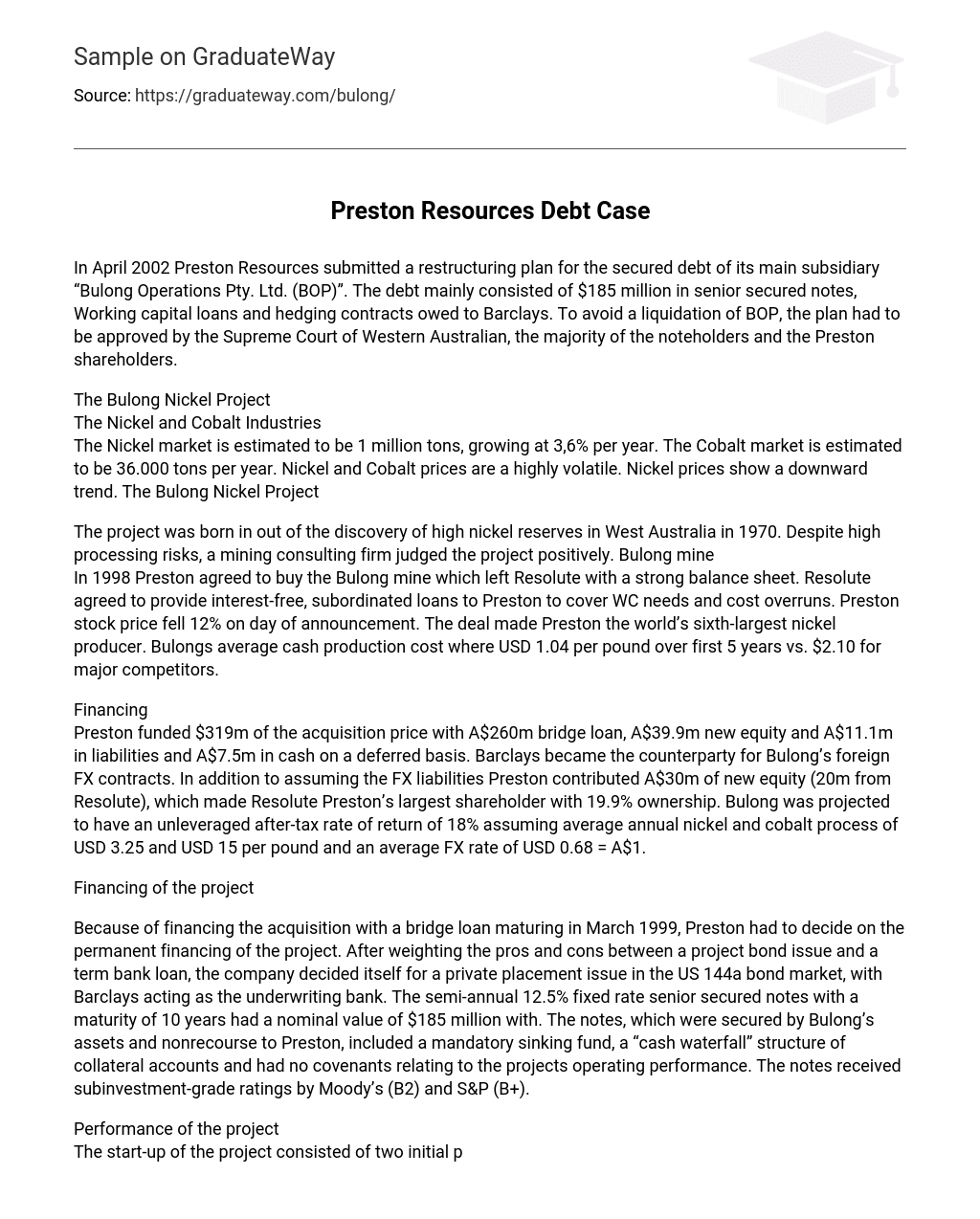In April 2002 Preston Resources submitted a restructuring plan for the secured debt of its main subsidiary “Bulong Operations Pty. Ltd. (BOP)”. The debt mainly consisted of $185 million in senior secured notes, Working capital loans and hedging contracts owed to Barclays. To avoid a liquidation of BOP, the plan had to be approved by the Supreme Court of Western Australian, the majority of the noteholders and the Preston shareholders.
The Bulong Nickel Project
The Nickel and Cobalt Industries
The Nickel market is estimated to be 1 million tons, growing at 3,6% per year. The Cobalt market is estimated to be 36.000 tons per year. Nickel and Cobalt prices are a highly volatile. Nickel prices show a downward trend. The Bulong Nickel Project
The project was born in out of the discovery of high nickel reserves in West Australia in 1970. Despite high processing risks, a mining consulting firm judged the project positively. Bulong mine
In 1998 Preston agreed to buy the Bulong mine which left Resolute with a strong balance sheet. Resolute agreed to provide interest‐free, subordinated loans to Preston to cover WC needs and cost overruns. Preston stock price fell 12% on day of announcement. The deal made Preston the world’s sixth‐largest nickel producer. Bulongs average cash production cost where USD 1.04 per pound over first 5 years vs. $2.10 for major competitors.
Financing
Preston funded $319m of the acquisition price with A$260m bridge loan, A$39.9m new equity and A$11.1m in liabilities and A$7.5m in cash on a deferred basis. Barclays became the counterparty for Bulong’s foreign FX contracts. In addition to assuming the FX liabilities Preston contributed A$30m of new equity (20m from Resolute), which made Resolute Preston’s largest shareholder with 19.9% ownership. Bulong was projected to have an unleveraged after‐tax rate of return of 18% assuming average annual nickel and cobalt process of USD 3.25 and USD 15 per pound and an average FX rate of USD 0.68 = A$1.
Financing of the project
Because of financing the acquisition with a bridge loan maturing in March 1999, Preston had to decide on the permanent financing of the project. After weighting the pros and cons between a project bond issue and a term bank loan, the company decided itself for a private placement issue in the US 144a bond market, with Barclays acting as the underwriting bank. The semi‐annual 12.5% fixed rate senior secured notes with a maturity of 10 years had a nominal value of $185 million with. The notes, which were secured by Bulong’s assets and nonrecourse to Preston, included a mandatory sinking fund, a “cash waterfall” structure of collateral accounts and had no covenants relating to the projects operating performance. The notes received subinvestment‐grade ratings by Moody’s (B2) and S&P (B+).
Performance of the project
The start‐up of the project consisted of two initial phases: “commissioning” which included the testing of the plant’s major systems and the “ramp‐up” which included the processing of ore until the plant reached predetermined output and quality levels. Due to technical and material problems the completion of the first stage was delayed by two months. Further problems also delayed the processing so that output levels only were reached for a short‐term period resulting in substantial shortfalls of output volumes subsequently.
Start‐up financing
In contrast to projections problems delayed the needed revenue and its cashflows. So Preston used Resolute’s obligation to give interest free subordinated loans of A$44m in June ’99 and A$47m in June 2000. Furthermore it got a WC‐loan reaching A$30m by the end of 2000. After an extended period of default events by early 2002 Bulong and Preston owed the secured creditors more then A$700m.
The first and second restructuring plan
The first plan which couldn’t reach an agreement included eliminating DSRA requirement, capitalizing interest payments as new bonds and transferring equity interest in the Nickel Holdings to the creditors. The second plan came in effect in March 2002. The debt service was restructured in an equity fashion ‐ 95% of equity interest were transferred to the creditors while keeping 5% and the whole Marlborough project.
Conclusion
To become effective the Supreme Court of Western Australia had to determine that the plan benefited the debtor which should be legally solvent. In addition Preston’s shareholders and the creditors had to approve the plan. Otherwise some form of liquidation process would start initiated by creditors which could even start this when Preston filed for the Australian equivalent of chapter 11. But as there was a very low reference price in a similar case the restructuring seemed to be the best option for everyone.





